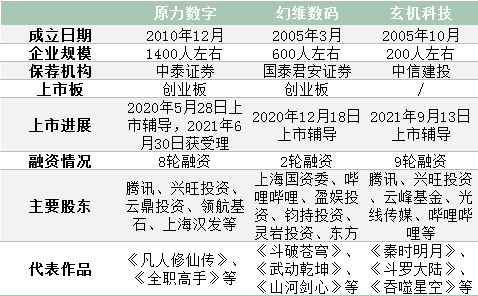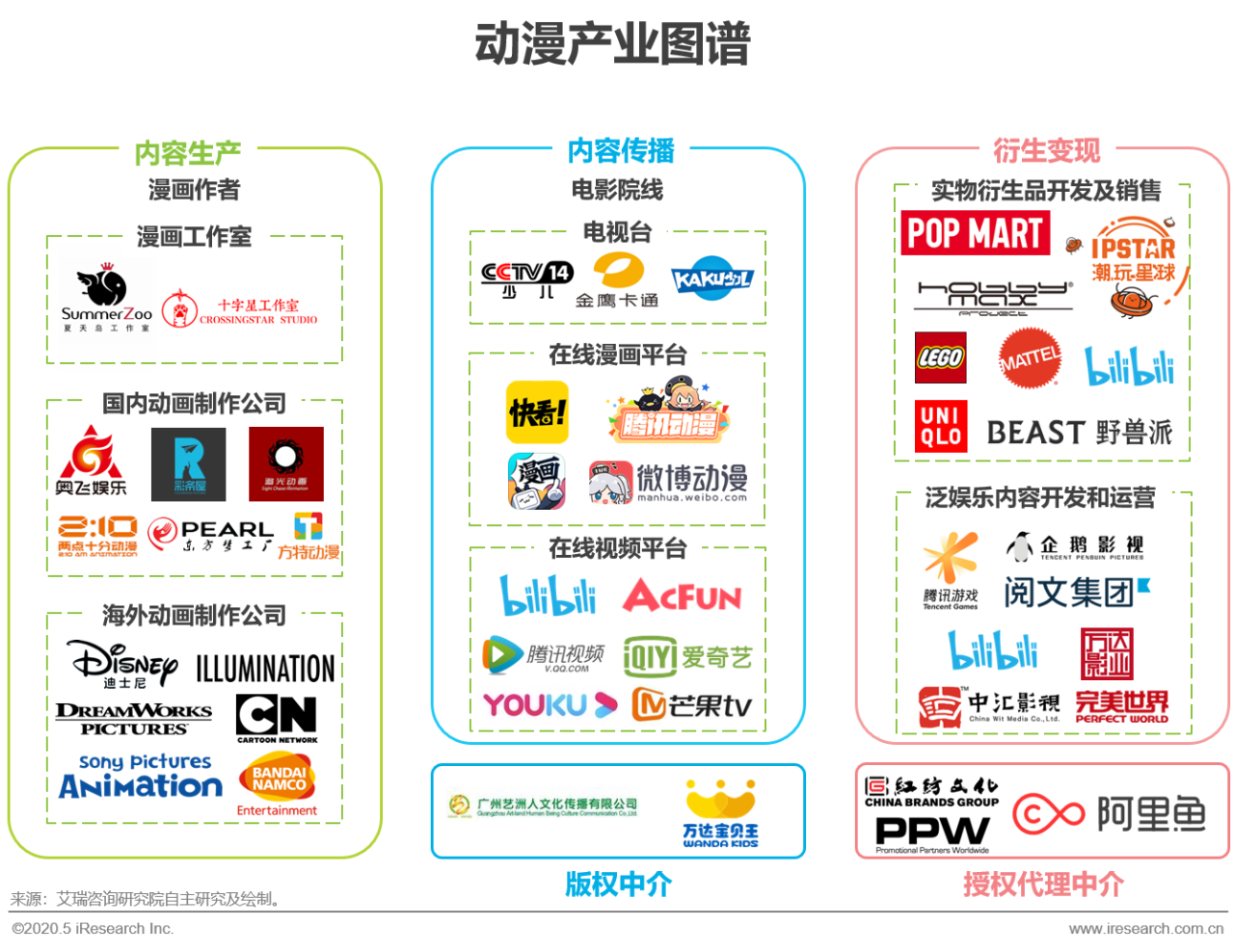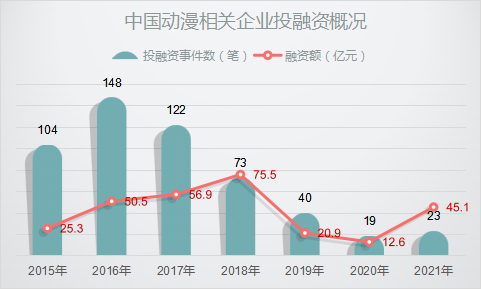Recently, the news about the delisting and re-listing of Ultraman Tiga has triggered a new round of discussion on the animation industry in the market. In addition to the voice of the State Administration of Radio, Film and Television to resist violent plot animations, which has aroused people’s attention to the supervision of the animation industry, since this year, in the capital market, animation-related companies have also been rioting frequently.
On September 13, according to the China Securities Regulatory Commission, Hangzhou Xuanji Technology Co., Ltd. (hereinafter referred to as “Xuanji Technology“), the producer of “Qin Shi Mingyue” and “Douluo Continent”, recently signed a listing guidance agreement with China Securities Regulatory Commission, plan A Previously, Shanghai Magic Digital Creative Technology Co., Ltd. (hereinafter referred to as “Magic Digital”), the producer of “Fights Break Sphere” and “Martial Universe”, also entered the listing counseling stage in December last year; Jiangsu Force Digital Technology Co., Ltd. (hereinafter referred to as “The Force Digital”), which has participated in the production of “The Legend of Mortal Cultivation” and “Mummy Duck”, has made faster progress. Currently accepted and undergoing a round of inquiries.
The three major national comic companies officially announced their listing, and the animation market is about to usher in a new capital structure.
The Force Digital “Game” revenue contest “animation”, closed the original “fundraising to replenish blood” after a big loss
Among the three companies mentioned above, Force Digital was the first to hit the capital market.
Force Digital signed a listing guidance agreement with Zhongtai Securities on May 28, 2020, and Zhongtai Securities issued a summary report on May 23, 2021. Subsequently, Force Digital submitted an IPO application to the Growth Enterprise Market on June 30, and has now gone through a round of inquiries.
The prospectus shows that Force Digital was established in December 2010 and is a high-tech enterprise in the 3D digital content production industry. From 2018 to 2020, Force Digital’s operating revenues were 351 million yuan, 311 million yuan, and 331 million yuan, and net profits were -286 million yuan, 13.87 million yuan, and 61.45 million yuan.
During the reporting period, its main business includes 3D digital content production service business and original digital content creation and investment business. Among them, the revenue from the 3D digital content production service business was 280 million yuan, 305 million yuan, and 325 million yuan, accounting for 81.66%, 99.84%, and 99.76% of the main business revenue, respectively, and from original digital content creation and investment The income of the business was only 6,819,300 yuan, 482,900 yuan, and 777,600 yuan, accounting for 18.34%, 0.16%, and 0.24% respectively.
Image source: The Force Digital Prospectus
3D digital content production service is the main business of Force Digital, which mainly includes the entrusted production business of game 3D content and the entrusted production business of animation 3D content. During the reporting period, Force Digital’s revenue from entrusted production of game 3D content was 145 million yuan, 167 million yuan, and 205 million yuan, accounting for 42.36%, 54.72%, and 62.98% respectively, mainly for games such as “Glory of the King” Outsourcing services such as three-dimensional images or art works of characters, objects, environments, etc. in the game; income from entrusted production of animation content is 132 million yuan, 131 million yuan, and 107 million yuan, accounting for 38.67%, 42.87%, and 32.70%, respectively , Successively mainly or participated in the production of well-known animation and film and television works such as “The Legend of Mortal Cultivation”.
From the above data, it is not difficult to find that Force Digital’s revenue from “games” has far exceeded that from “animation”. In 2020, Force Digital’s revenue from games will be nearly twice as much as animation revenue. High income and high gross profit are inseparable. The prospectus shows that in 2020, the gross profit of Force Digital game 3D content entrusted production is 77.79%, while the gross profit of animation 3D content commissioned production is only 18.00%, and the gross profit of Force Digital game is about animation. Four times the gross profit. In the future, Force Digital’s business may be further dumped into “gaming”.
In terms of original digital content creation and investment business, Force Digital has repeatedly run into walls.
On March 9, 2018, the original comedy animated film “Mommy Duck” directed by Zhao Rui, the CEO, director, screenwriter, and producer of Force Digital was released, but after the release, the film costing 200 million yuan only gained 38.147 million box office. Due to the poor box office, the film also triggered a series of problems such as investors’ request for equity repurchase and co-producers’ request for income compensation. According to the prospectus, the loss of the “Mama Mi Duck” project and the provision for inventory falling prices have a total impact of more than 300 million yuan on the net profit of Force Animation. In this IPO, Force Digital intends to raise 359 million yuan. Is it true? Make up for the accumulated losses incurred by it? After the failure of “Mommy Duck”, Force Digital returned its business to “production + limited trial and error”. Except for “The Big Monster in the Forbidden City”, it did not launch new original digital content creation and investment business.
In addition, according to the prospectus, the foreign sales revenue of Force Digital during the reporting period was 163 million yuan, 162 million yuan, and 188 million yuan, accounting for 47.65%, 53.08%, and 57.83% respectively. In other words, after Force Digital closed most of its original business in 2018, it has increasingly favored outsourcing business from foreign game animation companies. As an animation production company, Force Digital has clearly deviated from its “main business” in recent years. The content is the flesh and blood of animation. After the original business is closed, how can Force Digital survive in the increasingly competitive animation market?
According to the data from Tianyan Check, since its establishment in 2011, Force Digital has undergone 8 rounds of financing, and successively introduced institutional financing such as Tencent Investment, Xingwang Investment, and Yunding Capital. Among them, Tencent’s Linzhi Lichuang Information Technology Co., Ltd. holds 12.13%. The shares are its second largest shareholder.
Magic Dimension Digital and Xuanji Technology followed closely behind, supported by Tencent, Bilibili, etc.
After Force Digital, Magic Digital and Xuanji Technology have also started listing counseling.
On December 18, 2020, Magic Dimension Digital and Guotai Junan Securities signed a listing counseling agreement and intends to be listed on the Growth Enterprise Market.
Magic Digital was established in March 2005. In the early days, Magic Digital undertook more business cooperation work with well-known satellite TVs, and participated in the production of a large number of phenomenon-level variety shows that are beloved by the audience, such as “Extreme Challenge (Season 1)”. Since 2017, Magic Digital has also undertaken Several well-known domestic IPs have developed a number of excellent Chinese comics, such as “Bou Broken Sky”, etc., from the script adaptation to the launch of the animated series for the entire creation and production process.
In terms of shareholding structure, New Entertainment Media holds 47.70% of Magic Digital’s shares and is its controlling shareholder; Wenguang Group controls 47.70% of its shares through New Entertainment Media, and controls 8.00% of its shares through Oriental Pearl Asset Management, totaling 55.70. % Of the shares are its indirect controlling shareholder and legal person’s actual controller. Wenguang Group is a wholly-owned company of Shanghai State-owned Assets Supervision and Administration Commission, therefore, the ultimate controller of Magic Digital is Shanghai State-owned Assets Supervision and Administration Commission.
According to the data from Tianyan Check, Magic Digital has only experienced two rounds of financing since its establishment. In April 2018, Anchi Capital and Huaying Capital raised 60 million yuan in Series A financing of Magic Digital; in August 2020, Oriental Pearl Asset Management raised Magic Digital. Equity financing. In addition, in June 2021, Bilibili signed an agreement with Magic Digital, stipulating that Bilibili will invest in Magic Digital at RMB 69,565,217 million, and Bilibili will hold 8% of the equity of Magic Digital after the capital increase is completed.
Compared with Force Digital and Magic Digital, Xuanji Technology is much more famous in the “anime circle”.
On September 13, according to the Zhejiang Securities Regulatory Bureau, Xuanji Technology had signed a listing counseling agreement with China Securities, and planned to list A shares.
Xuanji Technology was established in October 2005, and its main products are non-low-age 3D animations. Up to now, Xuanji Technology has a total of 7 works, including 7 works such as “Qin Shi Mingyue” and “Douluo Continent”. Caijing.com has noticed that out of the seven works of Xuanji Technology, two have been suspended. Among them, “Tian Xing Jiu Ge” has been suspended for 2 years, and “Tian Yu” has been suspended for 3 years.
In addition, Xuanji Technology has frequently been exposed to situations where roles are highly similar and “guests” with each other. For example, the “Qian Renxue” in “Douluo Dalu” is convenient for Xuanji Technology‘s “Angel Saint King” previously created in “Wu Geng Ji”. “The images are highly similar. In addition, Xuanji Technology was caught in a plagiarism controversy because the fighting scene of the “Yang Wudi” corner in “Douluo Dalu” is highly similar to “The Five Elements of Wushan”.
According to data from Tianyan Check, Xuanji Technology has gone through 9 rounds of financing since its establishment, and has been held by many well-known investment institutions, such as Tencent, Xingwang Investment, Yunfeng Fund, Dunhong Assets, Weiying Capital, Guangguang Media, and Bilibili. All of them are among the top ten shareholders, of which Tencent (Linzhi Lixin Information Technology Co., Ltd., Tianjin Weiying Qiming Investment Center (Limited Partnership)) and Ali Group (Shanghai Yunfeng Xincheng Investment Center (Limited Partnership)) respectively It is the second largest and fourth largest shareholder, holding 20.54% and 5.28% respectively.

Image source: Caijing.com, compiled according to public information
Capital has begun to pick up, and the prospects of China’s animation industry can be expected
The animation industry refers to the industry formed around the production and production of animation content. The upstream is the production and production system of animation content, the midstream is the dissemination and viewing channel of animation content, and the downstream refers to the derivative industry around the application and authorization of IP image.

Image source: iResearch
According to iResearch’s analysis, China’s animation industry has developed relatively late, and is still in a growth stage compared with countries with highly developed animation industries such as the United States and Japan. However, due to the support of national policies and the rise of Internet video platforms, China’s animation industry has developed rapidly. Beginning in 2015, China’s animation industry has entered a period of rapid growth brought about by the early development of the industry, and gradually entered a period of stable growth after 2018. According to data from iResearch, in 2020, the scale of my country’s two-dimensional users has exceeded 400 million, and the output value of the animation industry has exceeded 200 billion.
The rapid development of any industry is inseparable from the intervention of capital. According to the observation of Caijing.com, from 2015 to 2018, stimulated by the cultural and entertainment environment, China’s animation industry is in a highly active period of capital operation, and both the investment must lose and the financing amount is increasing significantly. Affected by the capital winter that began in the second half of 2018, the number and amount of investment and financing related to China’s animation industry in 2019 have begun to dive. In 2020, the number and amount of investment and financing Industrial capital has begun to pick up. Although the number of investment and financing is basically the same as in 2020, the amount of financing is about four times that in 2020.

Image source: Caijing.com, compiled according to public information
The ultimate goal of the development of China’s animation industry is to compete with Hollywood in the United States. There will be giant companies like Disney and NBC Universal that are involved in the upstream, midstream and downstream of the industry and achieve diversified development. Given that China’s current animation industry is still in the early stages of industry development, the future is expected There will be more room for growth. This has also attracted more and more traditional industry giants, Internet giants, and new consumer companies to enter the animation market and become new players in this field. They are not only important participants in investment in the animation industry, but also continue to input capital relief funds for the animation industry. Under pressure, they will directly participate in the production of animation content through cooperation with animation companies in the form of investment works, and promote the blowout and IP development process of animation content production.
IT orange data shows that as of September 30, there are 1,360 related companies under the “anime” entry. However, according to wind data, there are currently only 17 animation companies listed on the A-share market, and 11 animation-related companies are listed on the NEEQ. The remaining more than 1,300 companies are not listed. It is expected that in the future, in the capital market, animation-related companies will have a lot of room for growth.
